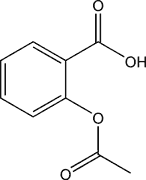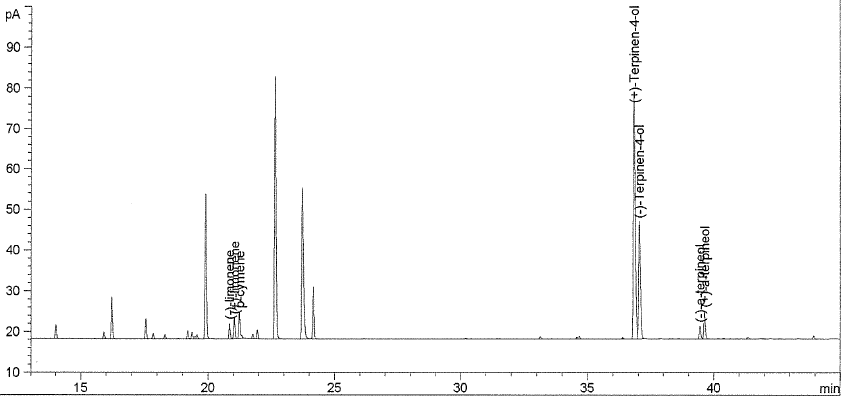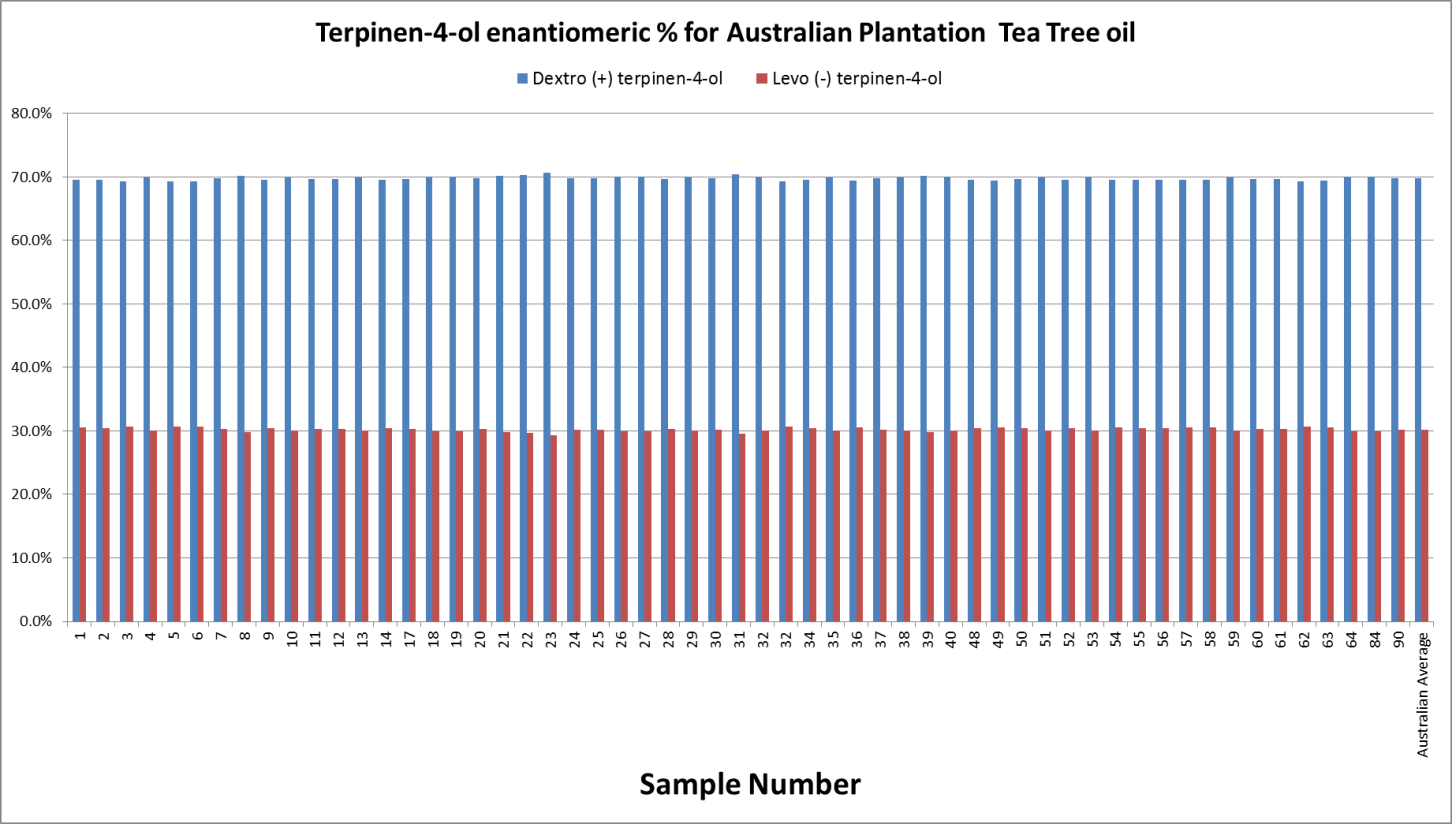A Gas Chromatographic (GC) Trace showing separation of the enantiomers of 3 compounds in Tea Tree oil.
The problem of Tea Tree adulteration became so massive and systematic with the perpetrators of adulteration dominating the Tea Tree oil market with impunity that ATTIA realized in 2009 that they had to do something.
They looked first at DNA markers but quickly found that this cannot work for Tea Tree oil because it is steam distilled so there is absolutely no DNA in Tea Tree oil so another method had to be found.
Then they looked at C14 analysis which differentiates between fossil and atmospheric sources of Carbon, this was rejected because in most instances adulteration appeared to be done a using modern (rather than fossil (oil) sources which means the test is not foolproof.
They also looked at the current Standard and quickly realized that none of them were robust enough to prevent adulteration because they were all outdated and perpetrators were smart enough to find ways around them.
So, the place to start was with samples of Tea Tree oil sourced both directly from Australian plantations and also from retail shops around the world. The idea here was to see if they could analyze these to find new parameters that are definitive (ie they clearly and incontrovertibly identified if the material was indeed sourced from M. alternifolia).
Using the Standards as a starting point ATTIA demonstrated that up to 70% of all commercial samples tested in some areas showed clear evidence of adulteration. Nearly all of these adulterated samples were so crudely adulterated that they could easily be detected if ISO 4730:2004 parameters were used but just a few showed a level of sophistication that made it very difficult to detect.
ATTIA then circulated the paper we looked at in an earlier lesson "How ISO 4730:2004 and AS 2782:1997 Standars Hep Identify Fraudulent Tea Tree Oil" which is available from this link. Within only a few months of its release the sophistication of adulterated material available in some markets, especially in Europa where adulteration was so prevalent, improved dramatically. This was an encouraging start so ATTIA decided to look deeper.
Nearly all other essential oils have similar issues with adulteration and one in particular, lavender oil which is expensive to produce especially the much sought after Lavandula angustifolia oil, had already identified a technique which ATTIA calls "Chiral Purity Testing" so this was investigated by a leading team of scientists based in Australia and the USA.
WARNING! This next section has a high level of technical content but if you persevere you will be able to grasp the basics and go on to understand how this can help the Tea Tree oil industry (and many other similar industries) to identify and so combat adulteration.
Many of the complex molecules in essential oils have a Carbon ring (also known as a cyclic compound) where one or more series of atoms in the compound is connected to form a ring. An example of a compound with a carbon ring that almost all people have heard of is "aspirin". This is shown in the image to the right:
more series of atoms in the compound is connected to form a ring. An example of a compound with a carbon ring that almost all people have heard of is "aspirin". This is shown in the image to the right:
Aspirin, also known as acetylsalicylic acid is found naturally in the leaves of the willow tree and has been used for its health effects for at least 2.400 years. Nowadays it is almost exclusively sourced synthetically because of the demand for this popular drug. It is also important to know that this is a single molecule, not the complex mixture of many molecules found in essential oils, so synthesis and production can be tightly controlled and high purity is guaranteed.
Some compounds with a Carbon ring can have two different forms: a left had and a right hand form. Imagine please that the Carbon ring is the palm of your hand and the structures attached to it are your fingers and thumb. Which hand you may ask and this is the key to chirality! Just like your hand some compounds can have a "left" form and a "right" form otherwise they are chemically identical- they are mirror images of each other as shown in the simplified image to the right.
that the Carbon ring is the palm of your hand and the structures attached to it are your fingers and thumb. Which hand you may ask and this is the key to chirality! Just like your hand some compounds can have a "left" form and a "right" form otherwise they are chemically identical- they are mirror images of each other as shown in the simplified image to the right.
Tea Tree oil contains several of these but we need to understand a bit more about this phenomenon first and how important they are to us all.
Thalidomide is a drug you may have heard of, it was given to pregnant women in the 1950´s and was found to cause deformity in children born to mothers who took the drug. It was withdrawn in the UK during the early 1960´s. This compounds has two forms- it is a chiral molecule as you can see in the image below so it has a Right or (+) form and a Left or (-) form:

Unfortunately for the tens of thousands of parents and babies born after exposure to this drug it was discovered that the two different forms (also known as enantiomers or optical isomers) act slightly differently. The (+) form causes birth defects while the (-) form acts as originally intended as a sedatie to combat morning sickness. If you want to know more about this, please search the internet for Thalidomide.
There are many other examples of chiral molecules in nature and another example is limonene which is most commonly found in citrus oils (e.g. orange, lemon, bergamot, etc).
Back to Tea Tree oil:
Tea Tree oil contains at least 4 chiral compounds, they are:
- Terpinen-4-ol.
- Limonene.
- Alfa terpineol.
- alfa pinene.
ATTIA collaborated with three Australian universities Monash University, the University of Tasmania and Southern Cross University as well as the US based University of Mississippi to investigate the occurrence of these three compounds in samples of Tea Tree oil collected directly from the distilleries of producer members to avoid the chance of adulterated samples. They repeatedly and accurately measured the percentage of each of the chiral forms (Right and Left) in more than 50 of these pure Australian Tea Tree oil samples collected over 5 years of production to see if , like lavender oil, this ratio would provide a unique, easy to measure and relatively fool-proof "fingerprint" for Tea tree oil steam distilled from M. alternifolia.
It worked! In all 57 samples (and another 70+ samples since then) the percentage or ratio of the Left and Right forms of three of these compounds (terpinen-4-ol, limonene and alfa terpineol) was remarkably similar regardless of when, where or how the plants were grown as shown in the graph below for terpinen-4-ol:
The graphs for limonene and alfa terpineol look nearly identical so they are not shown. The alfa pinene, because there is so little of it in pure Tea Tree oil is not as easy to measure so it was dropped.
If you are interested in the chemistry behind this and want to read some of the papers that have been published on this please visit the following links:
You also can read this text by ATTIA Adulterated_TTO_White_paper_formatted_DEC2012 (1) which gives some background into the early (2012) efforts by ATTIA members to keep the reputation of an iconic and high quality Australian essential oil intact.
If you are struggling with the chemistry please keep reading, it is further explained in the next sections, alternatively search for "chiral" on the internet and see what you can find.
Once all the investigative work was completed the researchers calculated the average for each chiral form (+) and (-) of the three molecules selected as most suitable in the 57 samples of 100% pure Australian plantation Tea Tree oil with the aim of helping to identify adulteration. This is shown in the table below. So now we can say that if the values in any sample are close to these then it is fair to say that the product is indeed steam distilled from 100% pure M. alternifolia.
In summary:
- Essential oils contain many different molecules.
- Most of these molecules are lare, complex structures made predominantly of Carbon, Hydrogen and Oxygen. These molecules can sometimes include other elements such as Nitrogen or Sulphur.
- Some of these complex molecules have a Carbon ring and some of these (not all) may have two forms: Right or (+) and Left or (-). These are called chiral molecules and scientists also sometimes call them enantiomers or optical isomers.
- Both forms of the molecule are chemically identical except, like you hand, they are mirror images of each other.
- Both forms may have different properties and effects if they enter the human body.
- When they are produced in a laboratory then, like tossing a coin, the molecule is formed with 50% of each ie 50% (+) and 50% (-).
- If they are formed in a natural process (ie in a plant) they are most commonly produced with one form predominant over the other.
- In Tea Tree oil the major component, terpinen-4-ol is ALWAYS produced by M. alternifolia in the ratio of approximately 70% Right or (+) and 30% Left or (-).
With this knowledge it is now possible to devise a simple test that can help identify if a sample has been adulterated.
It is also very important to know that these researchers have also examined oil extracted from the leaves of M. alternifolia not only from Australia but aso from China, Zimbabwe, South Africa and Kenya; in every single sample the chiral ratio was very close to the Australian average. This is no surprice because M. alternifolia is a native Australian plant and it doesn´t matter where, when or how it is grown; it ALWAYS porduces these three molecules in the same quantities:
A comment from Tony Larkman:
"Fortunately for us M. alternifolia is predominantly right (+) handed for terpinen-4-ol while the industrial waste, predominantly from Eucalyptus and other species. is left handed. If the chiral ratios for these three molecules are not as shown in the table +/- very little then the product is not and cannot be 100% pure TTO steam distilled from M. alternifolia, terpinen-4-ol type. ATTIA is currently investigating the chiral ratios of the other chemo-types which are close but marginal at best against these figures which is (if it all pans out) a pleasant bonus if it can be used to differentiate the chemo-types as well."
(SOURCE: Tony Larkman, private communication, 2016).
But wait! there is another minor problem that needs to be resolved before we go on; this won´t take long so please be patient and read the next section.
As we learned in a previous lesson (About Tea Tree oil) when a Standard for a naturally derived product is created it must allow for the natural variation that occurs. For example the terpinen-4-ol is never exactly (+) 70% and (-) 30% so some simple statistics based on a large sample are needed to provide a range. Fortunately there are known formulae for doing this so for Tea Tree Oil we can calculate the lower and upper ranges (in pink in the table below) which are based on 127 samples:
To explain this simply when the results come back from the laboratory you can look at the value for terpinen-4-ol and as long as the Right (+) is between 66.53 and 71.72 and the Left (-) is between 28.29 and 33.46 (a range of just over 5%) you can be reasonably sure that it is derived from M. alternia.
A final note before we go on: the range spread for both terpinen-4-ol and limonene is just over 5% while the range for alfa terpineol is slightly higher at just over 6,7%. This simply means the alfa terpineol is a slightly less reliable measure than the other two.
Now let's see this new knowledge applied to a real world situation with Spanish samples that were recently purchase; go on to the next lesson!






No Comments